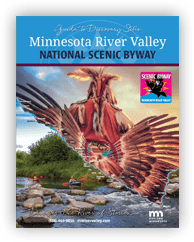The Minnesota River Valley is a special region unlike any other.
At the end of the last glacial period, the river valley was born in a series of dramatic and massive floods that resulted from the overflow of glacial Lake Agassiz. The river winds its way from the top of the continental divide to join with the Mississippi, and as it travels, it passes through some of the most fertile lands on earth, as well as rich wetlands and forests, and shifts between two major native biomes: the prairie and the Big Woods. In its valley, many animals, plants, and people have interacted to create a unique place.
The Minnesota River’s headwaters are born of the Little Minnesota River’s headwaters near Veblen, South Dakota, coalescing in a valley remnant of the last Ice Age at Browns Valley. From this western edge, the river travels through rich wetlands, prairies, granite outcroppings, wooded hills, farm fields, villages and small cities. Over millennia, the river valley’s people, plants, and animals have interacted in a complex and unique ecosystem. Throughout the valley, evidence of the interactions between these species can be seen.
Hover over a point on the map for just a bit of information or click on the point for even more detailed information about that location.
![]()
![]()
Useful Information








